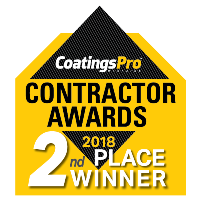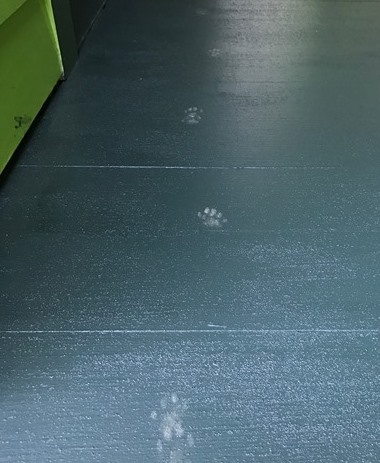Ulysses S. Grant was a victorious Civil War general who saved the Union and became the 18th President of the United States in 1869. Prior to the war, he met his future wife at her family home in St. Louis, Missouri, where both families lived for years.
While these historical figures have long since passed on, the home lives on as a tourist site run by the U.S. National Park Service (NPS). As such, keeping the nearly 200-year-old historic building operational requires major maintenance efforts, considering the desire for the site to accurately reflect its time period. Fortunately for the NPS, a five-person crew from regional contractor Capital Painting, Inc. embraced the challenge.
“It was a very unique project,” said Scott Miller, company president. “It’s not like painting a commercial or office building. It’s a historic feeling. We sent about half of our guys, and I just went out with them because I wanted to be there. You’re standing on the porch and you’re looking onto the same land that was there in the 1800s so you think back. That was the middle of a plantation, with slaves at the time. It was just surreal to paint an ex-president’s home that was part of the Civil War.” Surreal indeed.
Specifications called for the home’s exterior wood siding, soffits, doors, shutters, windows, and decks to be coated with a two-coat system for protection from the elements — along with the appropriate aesthetics of high-gloss green paint.
“The house was originally white, but Grant had it painted Paris green,” Miller said. “Vivid colors in the 1800s meant you were wealthy, and that showed an example of wealth. And high-gloss paint was what they used during that period.” Interestingly, the house is named “White Haven” for the family of one of the home’s earlier owners.
Manning Battle Stations
Work was completed over a six-day period in September 2017 when weather was mild and dry; however, since the project took place outside, this meant the home’s interior could remain open to tourists. Naturally, the steady stream of people created a logistics challenge for the Capital Painting crew.

“While we painted one side, they would load tourists through either the front door or the rear, then shift around through the house,” Miller explained. “They were set tours. As they came in, we shifted, or we pre-planned for which side or which hour of the day.”
“I should know the entire speech by now,” Miller joked, referring to the tour guides.
Capital Painting, now in its 13th year of existence, had an existing relationship with the NPS from prior projects — and that trust paid off, given the tourism concerns.
“Communication was a big deal on this one,” Miller said. “These jobs are bid, but they don’t always go to the low bid. Your past experience is big on other historical structures.”
That trust proved critical because, on this job, the painters had to remain composed at all times — even in the presence of gunfire! “One day they had a Civil War reenactment, so they were shooting off cannons and Civil War-era rifles,” Miller recalled. “It was very loud.”
Prepping for Time Travel
To keep the site resembling its era as closely as possible, preparation and application methods needed to reflect the original time period. For the Capital Painting crew, this was quite a change from a typical job! Personal protective equipment (PPE) was minimal, effectively consisting of just gloves and boots because they were not allowed to use complex modern equipment.
 “On the first day, we hand-washed all the dirt and mildew by bucket and rag,” Miller recalled. “We couldn’t use a pressure washer because of the sensitive nature of the wood and the historic nature of it. Not to mention that they didn’t have pressure washers back in the 1800s.”
“On the first day, we hand-washed all the dirt and mildew by bucket and rag,” Miller recalled. “We couldn’t use a pressure washer because of the sensitive nature of the wood and the historic nature of it. Not to mention that they didn’t have pressure washers back in the 1800s.”
Workers also scraped down any loose paint using hand tools from Purdy.
“They did not have a surface profile, because in the 1800s, there wasn’t really a standard,” Miller explained. On the second day, the crew spot primed the raw areas where paint had fallen off using the Sherwin-Williams A-100 Exterior Fast Dry wood primer, applied with 3-inch (7.6 cm) Purdy Swan brushes at approximately 4 mils (101.6 microns) of wet film thickness (WFT). Werner ladders were used to allow workers to reach higher areas.
“It wasn’t 100 percent coverage with the primer,” Miller said. “Just spot coverage as needed for the raw areas.” The deck was primed after the last tour of the second day, allowing it to cure overnight without anyone walking on it.
Winning the Job
The final four days of the assignment consisted of hand-painting the home. Sprayers were not an option, again for historic reasons, so the crew used the same Purdy Swan brushes all around.
Doors, windows, shutters, and siding received two coats of Sherwin-Williams’ SuperPaint Exterior Acrylic Latex, designed to retain color and resist fading and peeling. Each coat, applied at approximately 4 mils (101.6 microns) WFT, cured within hours before the second coat was brushed on the next day.
“It’s a water-based product with a fast drying time,” Miller said. “The siding and the home were simple, since no one touches or walks on it, generally. They did have a porch on the front and the rear, so when we’d do one side, they’d close down that area [to tourists]. We used ribbon tape to segment off.”
For the porch areas, the decks and stairs were coated with two coats of Sherwin-Williams’ Porch & Floor Enamel — each also at an average of 4 mils (101.6 microns) WFT — along with a non-slip sand additive to prepare those areas for foot traffic.
As it turned out, tourists weren’t the only obstacle on this project. The “White Haven” home is located adjacent to Grant’s Farm, now operated by Anheuser-Busch Brewing Company. As such, the farm is home to a wide variety of animals, including the famous Budweiser Clydesdales. While the horses didn’t make it to the jobsite, a few other animals did!
“We did have wildlife walking on the finished floor for the first coat,” Miller recalled. “I saw a fox run off the deck, and there were cat footprints, too.” But because of fast curing times, it wasn’t a problem. “They didn’t ruin anything,” Miller said. “Just left a dusty footprint.”
In the end, the Capital crew successfully finished on schedule — and the archived Civil War site remains very much alive, even in the 21st century. “They said ‘great job’,” Miller said of the client. “We had a walkthrough, and they were very happy with the deadline and how it looked. Our history with them [NPS] is really good, so they keep coming back to us.”
For the crew, the novelty of this job made the experience even more memorable — and perhaps even inspired their great work.
“It was just a very unique project that was fun to be a part of because of the history,” Miller said. “It was really basic. No sprayers, no fancy equipment, no special prepping. It was just going back to the basics of painting.”
That back-to-basics approach certainly paid off, even on a job that was anything but.
Editor’s Note: Capital Painting won 2nd place in the Specialty Project category for CoatingsPro’s 2018 Contractor Awards Program for this project. Congrats to the crew!
